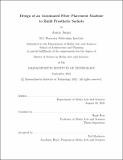Design of an Automated Fiber Placement Machine to Build Prosthetic Sockets
Author(s)
Jaeger, Aaron
DownloadThesis PDF (7.954Mb)
Advisor
Herr, Hugh
Terms of use
Metadata
Show full item recordAbstract
This thesis presents research towards an automated manufacturing method for producing prosthetic sockets and orthotic interfaces. The prosthetic socket is a noninvasive mechanical interface between the residuum and the prosthesis. There is no standardized method for socket fabrication, but they are generally produced by hand laminating a carbon fiber or other composite around a hand sculpted form. This process is expensive, lacks quality control, and limits future socket improvements. Automated manufacturing is a potential way to reduce labor costs and improved quality through standardization.
Automated fiber placement (AFP) is a process commonly used in the aerospace industry to make large, complex composite parts where a robotic gantry lays down individual pre-impregnated strips of fiber tow. This thesis prototyped a proof-of-concept desktop AFP machine with four degrees of freedom designed for building prosthetic sockets for $10,000 at a scale feasible for small clinics, university research labs, and residential settings. The AFP prototype demonstrated the basic ability to automatically place and laminate strips of fiber. During testing the prototype demonstrated a constant compaction force at 75N with standard deviation of 1.2N over varying surface and produced the 10N of fiber tension that is required for composite lamination.
Date issued
2021-09Department
Program in Media Arts and Sciences (Massachusetts Institute of Technology)Publisher
Massachusetts Institute of Technology